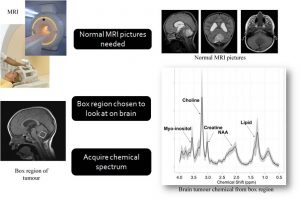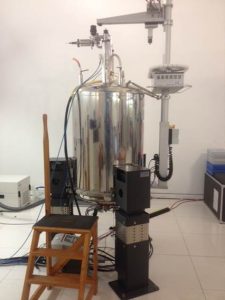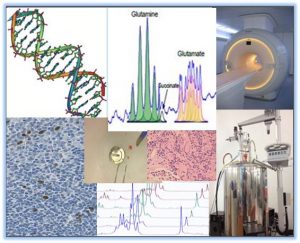 ‘Utilising non-invasive MRI measures to predict survival outcomes in childhood brain tumour patients‘ Ben Babourina-Brooks
‘Utilising non-invasive MRI measures to predict survival outcomes in childhood brain tumour patients‘ Ben Babourina-Brooks
In my research I use advanced MRI (Magnetic Resonance Imaging) techniques to measure chemicals and temperature in the brain. I use these techniques to help us distinguish between different types of tumours to help the clinic make better treatment decisions for patients.
 ‘Advanced MRI of childhood brain tumours’ Chris Bennett
‘Advanced MRI of childhood brain tumours’ Chris Bennett
My work involves working on brain tumour tissue frozen after surgery. This allows us to examine real tumour tissue in more detail than we can with an MRI (Magnetic Resonance Imaging) scanner, helping us to better understand imaging and spectroscopic features of brain tumours.
 ‘Diagnosing brain tumour through functional imaging and deep learning’ Dadi Zhao
‘Diagnosing brain tumour through functional imaging and deep learning’ Dadi Zhao
Conventional MR (magnetic resonance) imaging is able to provide useful information on the structure, and functional imaging (spectroscopy) can aid getting estimates of certain chemicals (called metabolites) in the tumour. In this project I am trying to find a novel way to realise automatic brain tumour classification through machine learning, in the same exact area of the brain, to better determine which type and grade of brain tumour a patient has.
 ‘Establishing the added value of advanced imaging techniques in clinical practice’ Karen Manias
‘Establishing the added value of advanced imaging techniques in clinical practice’ Karen Manias
My research involves establishing how the newest MRI (Magnetic Resonance Imaging) methods help doctors diagnose children with cancer and better understand how well the treatment is working. the main aim of my work is to take the latest imaging methods developed by the CBTRT back to the doctors in the clinic to improve patient care.
 ‘Non invasive identification of medulloblastoma genetic subtypes using metabolite profiles and imaging features’ Sarah Kohe
‘Non invasive identification of medulloblastoma genetic subtypes using metabolite profiles and imaging features’ Sarah Kohe
My main project is funded by Children with Cancer UK and involves the development of rapid and non-invasive methods of identifying the different genetic types of medulloblastoma based on their metabolite (chemical) profiles and the other features that we can see using MRI (Magnetic Resonance Imaging). Finding out how we can diagnose (or identify) these earlier and non-invasively will help doctors better plan treatment, and have more informed discussions with the patient and their family in the crucial early stages after the tumour has been found. Improving our understanding of the metabolite pathways in these different types (or subgroups) of medulloblastoma also means that we might find new ways to treat this.
